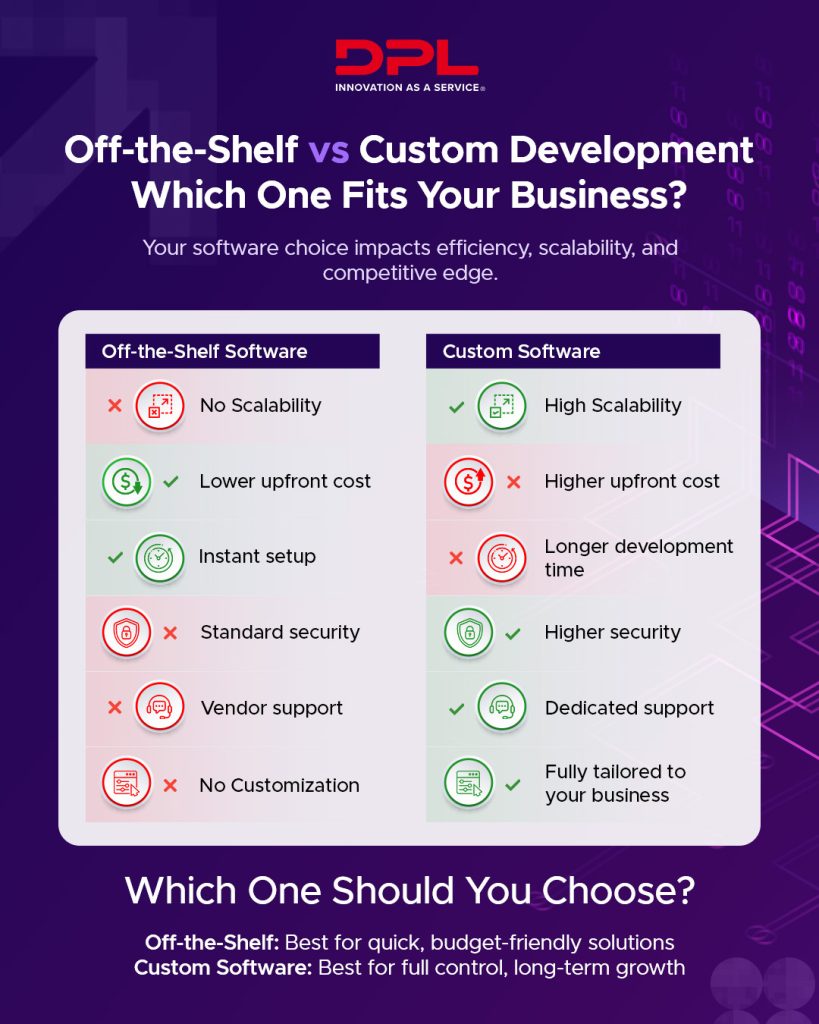Off-the-Shelf Software or Custom Development – A Guide to Making the Right Choice

One of the important choices you’ll make as a business owner is that between off-the-shelf software and custom applications. What you pick can influence your company’s operational efficiency, adaptability, competitive edge, and ability to scale.
To help you determine which path will best serve your business goals, let’s explore both sides thoroughly.
What Is Commercial Off-the-Shelf Software?
Commercial off-the-shelf software (COTS) is pre-built, pre-configured, and commercially available solutions to the business world’s typical problems.
Also known as out-of-the-box software, these applications are sold commercially or made available via subscription for widespread use. Common examples include:
- Productivity software such as Microsoft Office and Google Workspace
- Accounting and financial management software like QuickBooks and Xero
- Customer relationship management (CRM) software, which includes Salesforce and HubSpot
- Human resources management software such as Workday BambooHR
Pros of Off-the-Shelf Computer Software
If you’re considering commercial off-the-shelf apps for your business, you should weigh the pros and cons of this choice.
Starting with the advantages of this type of software, here are the top five:
- Rapid Deployment – Off-the-shelf solutions enable swift deployment. Businesses can address pressing needs quickly without delays.
- Cost-Effectiveness – The upfront costs of packaged software are typically lower than custom-built options, making it a budget-friendly choice.
- Proven Reliability – Commercial off-the-shelf solutions have been extensively tested and used by a large user base. Therefore, they tend to have a track record of stability and performance.
- Community Support – Almost all commercial software comes with a vast user community in the form of forums and user groups. These help users by providing valuable resources and tutorials.
- Scalability – Off-the-shelf software can easily scale to accommodate growing business needs. As a result, the risk of outgrowing the solution is usually lower.
Cons of Off-the-Shelf Software
As popular as out-of-the-box software is you should take into consideration its shortcomings. Mainly –
- Generic Solution – Off-the-shelf solutions may not fit an organization’s requirements to the letter. This may result in suboptimal solutions or the need for workarounds.
- Limited Customization – There are usually constraints to the extent of customization possible within this software. This, in turn, can impact business processes.
- Ongoing Costs – While the initial cost might be considerably low, subscription fees, maintenance costs, and update charges may be considerably high in the long run.
- Vendor Dependence – Companies that use off-the-shelf software are at the vendor’s mercy for maintenance, enhancements, and new releases. And this can be a problem if the vendor withdraws the product or ceases to trade.
- Security Risks – Pre-existing software can be prone to security threats and hacks if not configured or upgraded adequately.
What Is Custom Software?
Custom software, also known as bespoke or business-specific software, is a technology solution developed to meet the unique requirements of a specific business or organization.
Unlike generic, off-the-shelf application software, custom software is purpose-built from the ground up to align with a company’s workflows, preferences, and operational strategies.
It’s developed to solve certain problems, perform unique tasks, and facilitate specific activities that generic software usually doesn’t. Moreover, it integrates with other systems, portrays an organization’s vision, and addresses the complex nature of the business.
Pros of Custom Software
There are many great reasons to choose custom software over commercial software, including the following six.
- Tailored Fit – Custom software is highly personalized. Unlike off-the-shelf software solutions, it’s developed considering the organization’s operations, goals, and needs.
- Added Flexibility – Custom apps are designed to expand and adapt to the company’s needs over time. Therefore, they can adapt to changes in business processes, technology, etc., providing maximum value.
- Complete Ownership – In terms of usage, modifications, and scalability, custom software has the advantage of avoiding vendor lock-ins and high-cost restrictive pricing.
- Cost-Effectiveness – While it’s relatively costlier at the onset, custom-made software doesn’t have recurring subscription costs. This makes it a worthwhile investment, especially since it increases productivity and decreases expenses in the long run.
- Dedicated Support – Your custom software developers will oversee maintenance. This makes improvements or updates easier (and quicker).
- High Performance – Custom software is often considered high-performance since it’s designed specifically to meet the unique requirements of a business or organization. This ensures better efficiency and results.
Cons of Custom Apps
There are a few limitations you should consider before opting for custom applications. Mainly the following four:
- Higher Initial Cost – Unlike off-the-shelf software, custom software may seem a little pricey at first. This may especially deter small to medium enterprises.
- Longer Development Timeline – Developing custom software is a lengthy process, which may not be ideal for companies in need of quick fixes. So, unless you go for an Agile company or a skilled team of developers, you may not effectively reduce development time.
- Risk of Over-Complexity – Custom software can be complex since it demands extensive collaboration between developers and stakeholders. It also needs more time due to tailored development, unique functionalities, and integration with existing systems.
- Project Uncertainty – Like any other software development project, custom software development may be associated with issues like cost overruns, time overruns, or inability to meet objectives due to poor planning and control.
Off-the-Shelf Solutions vs. Custom Software – Factors to Consider
Now that you have a better understanding of both, it’s time to evaluate which one is right for your business needs. For that, you should base your decision on the following critical factors.

Ease of Customization
The number of modifications you need to make is an important decision factor to consider.
Off-the-shelf software is generally difficult to customize. It’s designed for broad, generic use rather than specific needs. Plus, its fixed architecture often makes it challenging to modify without vendor support, additional costs, or compatibility issues.
Custom software, on the other hand, is more adaptable and can be easily changed to align with the current technology and business trends.
Development and Deployment Durations
When it comes to COTS, the development and deployment durations are typically short since the software is pre-built and readily available. You can start using it almost immediately after purchase or signing up since it requires minimal configuration.
In comparison, custom-made software takes significantly more time because it’s made from scratch. The process involves extensive analysis, design, coding, testing, and integration phases.
Similarly, deploying custom solutions needs more time due to the need for thorough testing and system integration. Adjustments during implementation may also demand more time to ensure successful deployment.
Competitive Advantage
When it comes to competitive advantage, custom software often provides a significant edge over off-the-shelf solutions.
Custom software is built specifically to address the unique needs and goals of an organization. This ensures the solution aligns seamlessly with your processes. It also gives you an edge over the competition since you get to streamline operations and respond quickly to changing demands.
On the other hand, off-the-shelf software is widely available and used by many organizations. Its generic nature limits its ability to provide tailored solutions that truly set a business apart.
Compatibility Issues
COTS software can have compatibility problems with your current systems, making it impractical or impossible to use. Moreover, such solutions may include unnecessary features that may affect the speed of the operation.
Opting for custom development, on the other hand, can ensure your solutions complement your existing environments. This enables them to integrate well and function effectively.
User Experience
Generic software tends to deliver a standardized user experience, making it user-friendly and intuitive. Its polished interfaces, extensive documentation, and established support networks enable users to adopt it quickly.
However, this standardization can limit its alignment with unique workflows. This can compromise usability when it comes to niche requirements.
As for custom software, this comes with a tailored user experience designed specifically for the unique needs of an organization. It can incorporate precise workflows, unique functionalities, and branding, enhancing efficiency and satisfaction.
Yet keep in mind that this software may require a steeper learning curve, more extensive training, and potential usability refinements during deployment.
Convinced That Custom Software Is the Answer?
Then look no further than DPL! We have the expertise to build your custom software, future-proof your business, and turn your ideas into reality.
Share your requirements in the form below, and let’s build tailored applications that empower your entire business.





